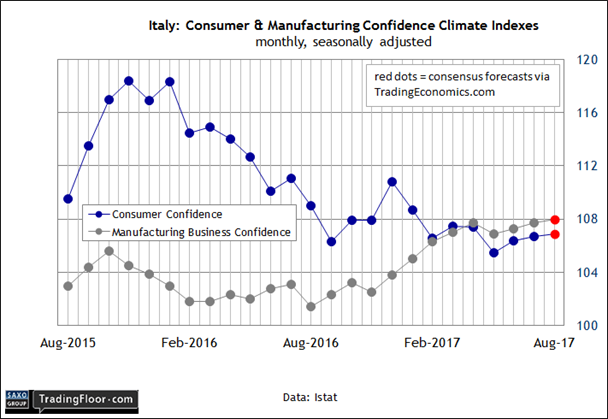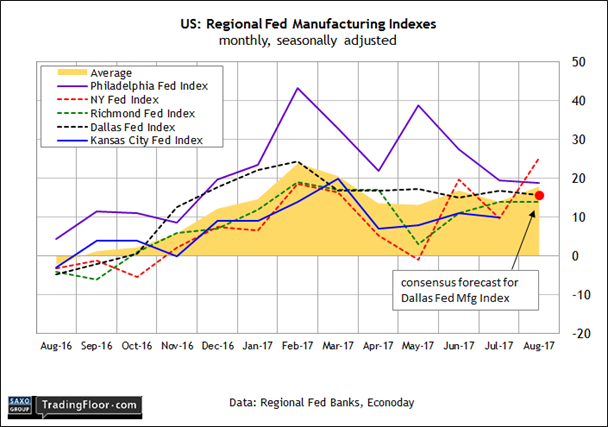- The rate of growth for M3 money supply in the Eurozone should reduce for July
- Output in Italy, the third largest EU economy, is rising at a moderate, steady pace
- Consumer and business confidence in Italy is on track to rise again for August
- The US Dallas Fed manufacturing index should maintain moderate growth profile
Money supply data for July is the main event for new economic data in Europe today. We’ll also see the August update on consumer and business sentiment numbers for Italy, followed by this month’s release of the US Dallas Fed manufacturing index.
Eurozone: Money Supply and Private Sector Loans (0800 GMT): The week kicks off with the first economic release for the euro area in the wake of European Central Bank President Mario Draghi’s speech on Friday at the Federal Reserve's Jackson Hole conference.
Although global economic growth is picking up, “a significant degree of monetary accommodation is still warranted,” Draghi said. The European recovery, he added, “is at an earlier stage" compared with the US, which suggests that the ECB isn’t planning to tighten policy in the immediate future.
The crowd will be looking for fresh macro context via the monetary profile for July. TradingEconomics.com’s consensus forecast for broad M3 growth calls for a fractional dip in the year-over-year rate to 4.9% from 5.0% in June. But that’s still in line with relatively steady pace in recent months, which implies that the central bank is using a 5% trend as a rough target.
Meanwhile, keep your eye on the narrow gauge of money supply (M1), which has been trending up this year. M1 increased 9.7% in June vs. the year-earlier level – a moderately faster gain vs. the recent low of 8% as of last October. Another rise would strengthen expectations that the ECB will maintain its aggressive stimulus policies for the near term.
Another key data set to watch in today’s report: the rate of growth in loan data for the private sector. Loans to households, for instance, increased 2.6% year-over-year in June, matching May’s pace as the fastest rate in eight years – a bullish signal for the economic outlook. If the trend holds steady or ticks higher, the news will boost confidence that the Eurozone’s rebound remains on track for the second half of the year.

Italy: Business and Consumer Confidence Indexes (0800 GMT): Europe’s third-largest economy is showing signs of life this year, and today’s sentiment data is expected to reaffirm that there’s more upside bubbling for the rest of the year.
Confidence benchmarks for the manufacturing and consumer sectors are projected to tick higher, according to TradingEconomics.com’s consensus estimates. The consumer benchmark is expected to edge up to 106.9 for August, which would mark a four-month high. Meantime, the manufacturing index is on track to rise to 108.0, the highest in nearly a decade.
A positive skew to Italy’s data isn’t surprising in the wake of upbeat GDP numbers this year. Output for the country has expanded 0.4% in each of the past three quarters through Q2. That’s below the 0.5%-0.6% trend for the Eurozone overall, but the fact that Italy’s output is rising at a moderate, steady pace suggests that the forward momentum will continue.
Sentiment data via IHS Markit certainly reflects a rising optimism. Earlier this month the consultancy reported that Italy’s Services PMI reached a ten-year high last month while the Manufacturing PMI points to a healthy growth rate at the start of Q3.
Given this backdrop, today’s update on the mood from Istat, Italy’s statistics agency, will probably provide more evidence for thinking positively about the near-term economic outlook.

US: Dallas Fed Manufacturing Index (1430 GMT): Durable goods orders fell sharply in July, sliding the most in almost three years. Today’s sentiment data for the manufacturing sector, however, will probably take some of the sting out of last week’s news.
Expectations for another positive reading for the Dallas Fed’s manufacturing index in August will mark the fifth upbeat data point via the regional Fed benchmarks for the sector. Econoday.com’s consensus forecast calls for a slight dip to 15.7 from 16.8 in July. But that’s still an encouraging reading; if it holds up, the average print for the five Fed bank indexes will rise to a five-month high in August.
Nonetheless, exports have been a weak spot for manufacturers lately. “Foreign goods orders fell – albeit only marginally – for the second month in a row [in August], often blamed on the strength of the dollar,” said an analyst at IHS Markit last week. “The domestic demand picture should hopefully remain relatively bright to offset such risks, however.”
The numbers published for August via the regional Fed banks suggest as much, and today’s update from the Dallas Fed probably won’t conflict with the upbeat trend.
Optimists point to the fact that non-defence capital goods orders excluding aircraft, a proxy for business investment, rose a modest 0.4% in July. Some analysts see that as a sign that the headline slump in orders last month may be a temporary setback, primarily due to a drop in aircraft orders, which tend to be highly volatile from month to month.

Disclosure: Originally published at Saxo Bank TradingFloor.com
